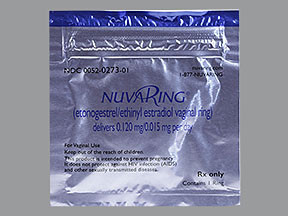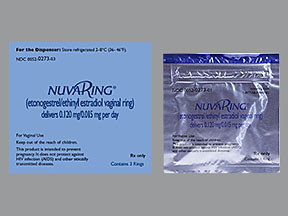ETONOGESTREL/ETHINYL ESTRADIOL RING - VAGINAL
PHONETIC PRONUNCIATION: (e-TOE-noe-JES-trel / ETH-i-nil ES-tra-DYE-ol)
COMMON BRAND NAME(S): Nuvaring
GENERIC NAME(S): etonogestrel/ethinyl estradiol
Uses
USES: This product is a vaginal ring containing combination hormone medication and is used to prevent pregnancy. It contains 2 hormones: a progestin (etonogestrel) and an estrogen (ethinyl estradiol). It works mainly by preventing the release of an egg (ovulation) during your menstrual cycle. It also makes vaginal fluid thicker to help prevent sperm from reaching an egg (fertilization) and changes the lining of the uterus (womb) to prevent attachment of a fertilized egg. If a fertilized egg does not attach to the uterus, it passes out of the body. Using this product does not protect you or your partner against sexually transmitted diseases (such as HIV, gonorrhea, chlamydia).
How to use ETONOGESTREL/ETHINYL ESTRADIOL RING - VAGINAL
HOW TO USE: Read the Patient Information Leaflet provided by your pharmacist before you start using this product and each time you get a refill. The leaflet contains very important information on how to properly use and dispose of the vaginal ring. If you have any questions, ask your doctor or pharmacist. This product is for vaginal use only. Before use, wash and dry your hands. Remove the ring from the reclosable foil pouch, keeping the pouch for later disposal of the used ring. Fold the ring in half and gently push it into your vagina as directed, until it feels comfortable. Although some women may be aware of the ring in the vagina, most women do not feel it once it is in place; it will not interfere with sexual intercourse (though your partner may be able to feel the ring). Unlike a diaphragm, the ring's exact position in the vagina does not affect how well it works. Once inserted, keep the ring in place for 3 weeks in a row. If this is the first time you are using the ring, use an additional form of non-hormonal birth control (such as condoms, spermicide) for the first 7 days to prevent pregnancy until the ring has enough time to work. Do not use a diaphragm, female condom, or cervical cap for additional birth control since the ring may interfere with proper placement. If you start using the ring on the first day of your period, you do not need to use back-up birth control the first week. After using the ring for 3 weeks, remove it on the same day of the week and about the same time that you placed it. Place the used ring back into the foil pouch and discard in the trash. Do not flush the used ring down a toilet. If you have pain/bleeding when trying to remove the ring, or if you cannot remove it, tell your doctor right away. Next, do not wear a ring for 1 week (7 days). You should have your period within 2 to 3 days after the ring is removed. After 1 ring-free week, insert a new ring on the same day of the week that you removed the old ring, whether or not you have your period. If you do not get your period, consult your doctor. Do not go longer than 7 days without a ring. Doing so will increase your risk of pregnancy. Regularly check that the ring is in your vagina, such as before and after sexual intercourse. The ring may accidentally fall out during sexual intercourse, during a bowel movement, or while removing a tampon. If this happens and the ring has been out of your vagina for less than 3 hours, rinse it with cool to lukewarm (not hot) water and re-insert the ring as soon as possible. If the ring has been out longer than 3 hours, you could become pregnant. Re-insert it or insert a new ring as directed and use an additional form of non-hormonal birth control (such as condoms, spermicide) for the next 7 days to prevent pregnancy. If you are not sure how long the ring has been out of your vagina, you may not be protected from pregnancy. Contact your doctor for a pregnancy test before inserting a new ring and using additional back-up birth control for 7 days. If you have left the ring in place longer than directed, up to an extra week (4 weeks total), you will still be protected from pregnancy. Remove the ring and insert a new ring after 1 ring-free week. However, if you have left the ring in place longer than 4 weeks, you may not be protected from pregnancy. Remove the ring and contact your doctor for a pregnancy test before inserting a new ring and using additional back-up birth control for 7 days. Rarely, the vaginal ring has broken at the weld joint after placement. This increases the chance of it slipping out of the vagina. If this happens, throw it away and use a new ring. Ask your doctor or pharmacist about how to switch from other forms of hormonal birth control (such as birth control pills) to this product. If any information is unclear, consult the Patient Information Leaflet or your doctor or pharmacist.
Side Effects
Precautions
Interactions
Overdose
Images
Reviews
Faq for ETONOGESTREL/ETHINYL ESTRADIOL RING - VAGINAL
- The ring releases hormones (etonogestrel and ethinyl estradiol) into the vagina, which are then absorbed into the bloodstream. These hormones prevent ovulation, thicken the cervical mucus, and change the uterine lining to prevent pregnancy.
- When used correctly, the ring is over 99% effective in preventing pregnancy. However, if used incorrectly or not used consistently, the effectiveness may decrease.
- The ring is inserted into the vagina and left in place for three weeks. After three weeks, it is removed by hooking a finger through the ring and pulling it out.
- It is possible to feel the ring during intercourse, but it usually does not cause discomfort for either partner. If it does, you can temporarily remove the ring and reinsert it within three hours.
- The ring should be replaced every three weeks, on the same day of the week it was initially inserted.
- Common side effects may include vaginal irritation, discharge, headache, nausea, breast tenderness, and mood changes. These side effects usually go away after a few months of use.
- Yes, you have the option to skip your period by immediately inserting a new ring after removing the old one. It is safe to do so, but it is best to consult with your healthcare provider to determine if it is suitable for you.
- No, the ring only provides protection against pregnancy. It does not protect against STIs. It is recommended to use barrier methods like condoms in addition to the ring to reduce the risk of STIs.
- Yes, the ring can help regulate periods for individuals with irregular cycles. It provides a consistent hormonal level that can help regulate the menstrual cycle.
Warning
WARNING: Do not use this medication if you smoke cigarettes/use tobacco and are over 35 years old. Smoking raises your risk of stroke, heart attack, blood clots, and high blood pressure from hormonal birth control (such as the pill, patch, ring). The risk of these serious problems increases with age and with the number of cigarettes you smoke. Do not smoke or use tobacco.
Disclaimer
IMPORTANT: HOW TO USE THIS INFORMATION: This is a summary and does NOT have all possible information about this product. This information does not assure that this product is safe, effective, or appropriate for you. This information is not individual medical advice and does not substitute for the advice of your health care professional. Always ask your health care professional for complete information about this product and your specific health needs.



No Reviews Yet